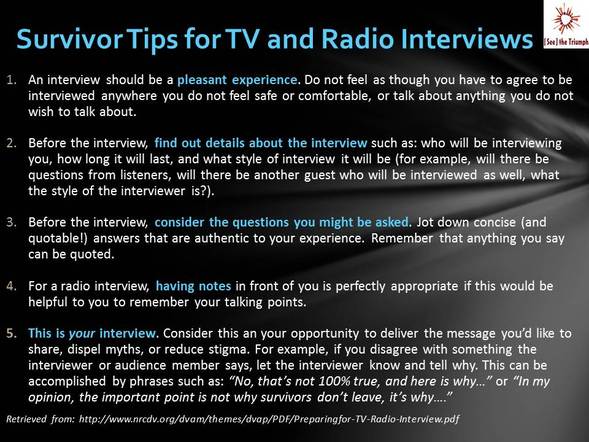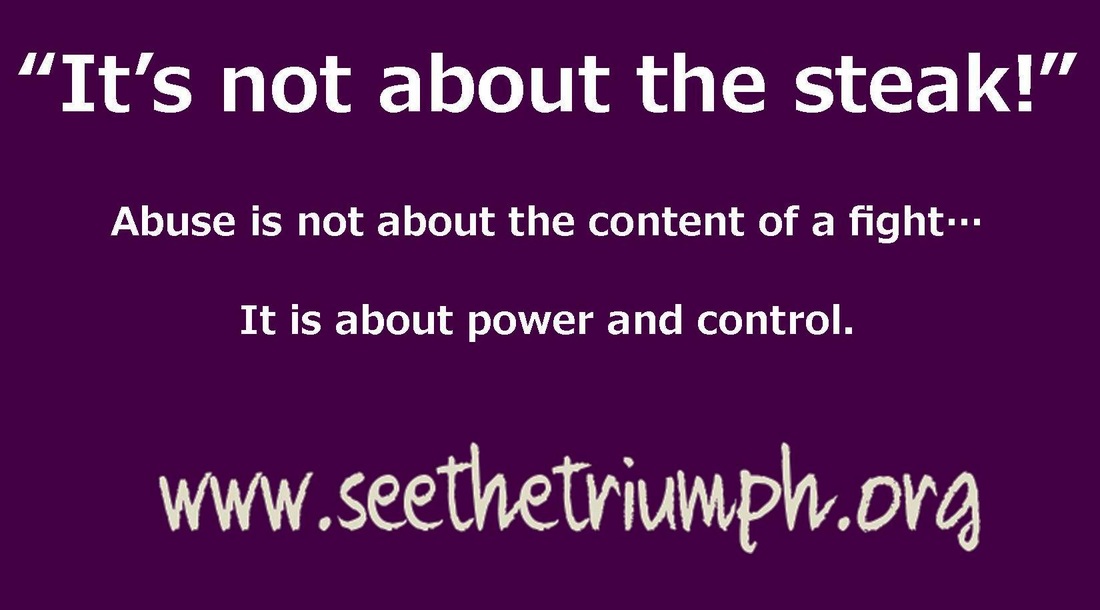|
11/16/2014 0 Comments How Can Advocates for Victims of Domestic Violence Raise Awareness of the Problem in Their Communities?By Doug Clark, See the Triumph Guest Blogger Ray Rice and Greg Hardy have become the most valuable players of awareness about domestic violence. The star football players are sitting out this season, and maybe longer, because of highly publicized assault cases where women were the victims. Rice, in particular, focused national attention on the cause because, initially, his punishment for knocking out his fiancee in an Atlantic City hotel elevator was a mere two-game suspension. Public opinion forced National Football League Commissioner Roger Goodell to order an indefinite suspension of the Baltimore Ravens running back — whom the team subsequently released. The Carolina Panthers sidelined Hardy, despite his $13 million salary, until his second trial on assault charges, which has yet to take place. When high-profile athletes attack a woman, the media and the public pay attention. That’s good, and not only because the publicity protects their victims. It also may warn other abusers that public tolerance of this behavior is very limited. Unfortunately, not every instance of domestic violence will become a national story. Far from it. Most of the time, a simple assault won’t even be reported on an inside page of the local newspaper. So, how can advocates for victims of domestic violence raise awareness of the problem in their communities? They actually have some tools at their disposal. One is simply to develop relationships with people who work in the media. They can contact reporters or editors and offer to comment with a local perspective on a national story or let them know that domestic violence is first and foremost a local story that happens in every neighborhood. They can provide statistical evidence, which is available from local law-enforcement agencies. A large portion of police calls relates to domestic conflicts, even though news reporters might not recognize that or choose to make it a story. When the numbers are added up, however, domestic violence turns out to be a big story in every city. There are other ways to quantify the problem. Recently, UNC Charlotte economics professor Stephen Billings authored a study that found domestic violence costs North Carolina $308 million a year. How many people think about domestic violence from a cost perspective, other than victims? But there are medical costs, lost work time costs, police costs, court costs and other expenses that truly make domestic violence everyone’s problem. These facts should be explained to the media. Of course, providing access to victims is very valuable. It’s also difficult because most victims don’t want to be publicly identified. They also don’t want to compromise potential legal cases by talking with the media. Arrangements can be made to keep names out of the paper or to disguise a subject’s identity in a TV interview. Or former victims may feel secure enough in their new circumstances to go public. Personal stories can be very powerful. Sadly, if the worst happens, domestic violence murder victims are always named in the papers. If speaking out might help, rather than hurt, before that point is reached, a victim might be brave enough to do that. Finally, domestic violence is a concern all year long, not only during Domestic Violence Month. Advocates should interact with the media when they have something to say. Thanks to a couple of football players, the public is listening.  Doug Clark is an editorial writer, columnist and blog author for the News & Record of Greensboro, N.C. He and his wife and have two sons and a granddaughter.
0 Comments
By Allison Crowe, See the Triumph Co-Founder
For the month of November, we are focusing on intimate partner violence, stigma, and the media. One of the ways survivors can de-stigmatize intimate partner violence is to agree to TV or radio interviews and share their stories, sending positive messages about who survivors are, the challenges one faces when trying to leave an abusive relationship, the myths that society holds about IPV, and other messages. The media often wants these interviews, too – getting survivors to speak out and tell their stories is powerful. But for some of you out there, this task might be overwhelming. You might ask yourself, “How do I tell my story in a way that will reach people?” or “What if I get emotional when talking about my past abuse?” Even practical questions such as “How do I know when to stop talking?” or “How do I avoid all the annoying habits I have when I speak in front of an audience?” The National Resource on Domestic Violence has some excellent tips for survivors on working with the media. Below, I have summarized some of these tips for preparing for a TV or Talk Radio Interview, and for those interested in reading more about any of this, I urge you to visit their web-site: http://www.nrcdv.org/dvam/themes/dvap/PDF/Preparingfor-TV-Radio-Interview.pdf 1. An interview should be a pleasant experience. Do not feel as though you have to agree to be interviewed anywhere you don’t feel safe or comfortable or talk about anything you don’t want to talk about. 2. Before the interview, find out details about the interview such as the following: who will be interviewing you, how long it will last, and what style of interview it will be (for example, will there be questions from listeners, will there be another guest who will be interviewed as well, what the style of the interviewer is?). 3. Before the interview, consider the questions you might be asked. Jot down concise (and quotable!) answers that are authentic to your experience. Remember that anything you say can be quoted. 4. For a radio interview, having notes in front of you is perfectly appropriate if this would be helpful to you to remember your talking points. 5. This is your interview. Consider this your opportunity to deliver the message you’d like to share, dispel myths, or reduce stigma. For example, if you disagree with something the interviewer or audience member says, let the interviewer know and tell why. This can be accomplished by phrases such as: “No, that’s not 100% true, and here is why…” or “In my opinion, the important point is not why survivors don’t leave, it’s why….” Most importantly, be yourself! Remember you have a story to tell that is powerful and impactful. All of us are responsible for doing our part to de-stigmatize intimate partner violence. The media can be a great way to do this, so if you feel talking with the media is something you want to do, then I encourage you to use these tips to feel ready and willing to have your voice heard! We can’t do it without you. By Christine Murray, See the Triumph Co-Founder
“We need a sea change in how women are portrayed by the media...A strong message that domestic violence is not acceptable needs to be conveyed backed up by punishments for the perpetrators. “ ~ Domestic violence survivor The above quote from a participant in our research illustrates the significant role that the media plays in shaping people’s opinions about intimate partner violence (IPV). When it comes to raising awareness about IPV, there is perhaps no more effective way to reach the masses than through the media. This includes newspapers, magazines, TV, and radio. And, in today’s digital age, this also includes web-sites, blogs, and various social media outlets. As media channels have become increasingly integrated, any one of these media outlets likely reaches people across multiple platforms. For example, a video from a TV news story is often posted on the channel’s web-site, which is then likely to be promoted on their social media channels, such as Facebook and Twitter. What does this mean for survivors and advocates hoping to raise awareness about IPV? For one thing, it means that there’s a huge potential for media stories about IPV to reach more people, for a longer period of time than ever before. This is great news, because more people understanding the dynamics of IPV and the resources available to help means there’s a wider network of people in our communities who are equipped to address this issue and support survivors. On the other hand, media coverage of IPV is not always helpful in raising awareness and educating the community, especially when stories are reported in ways that do not accurately describe the dynamics of abuse, use victim-blaming language, and--perhaps most dangerous of all--pose risks to the safety of victims and survivors. I saw several examples of problems that can arise when IPV is covered irresponsibly in the media recently with all the news coverage of the Ray Rice and other domestic violence cases in the NFL. These included the following:
We hope to hear from you this month, too. What have been your experiences in working with the media? We’d love to hear the strategies that worked for you in your local communities and beyond! By Christine Murray, See the Triumph Co-Founder
One of my simple pleasures in life is reading the newspaper every morning. I love getting up to date about the news of the day, learning about events and happenings in my community and beyond, and getting a daily dose of information about the important issues happening in the world around us. And yet, there are times when my daily newspaper reading turns into disappointment, frustration, and anger over upsetting news about injustices in the world around us. As one who cares deeply about ending intimate partner violence, some of my biggest frustrations come up when reading the paper and seeing stories about new cases of domestic violence. Every new story simply breaks my heart, because I believe that every person has a right to safe and healthy relationships. Beyond my frustrations when I read about cases of domestic violence, I, like many professionals who work to address domestic violence, get frustrated by the way that this issue is often covered in the media. For example, I remember one morning a few years ago reading about a man who had beat his female partner, which the newspaper stated happened because she didn’t cook his steak the way he liked it. If you could have read my mind at the moment I read that, you would have heard it screaming, “It’s not about the steak!!!!!!!!” In my view, the reason that man beat his partner had nothing to do with the way she cooked his steak, and it had everything to do with power and control. If you think that this story about the steak is an isolated incident, think again. Check out these examples of other “reasons” that media outlets gave for incidents of violence in the past month or so. I’ve bolded the alleged reasons for the violence in the list below:
It’s natural for people to want to try and explain why violence occurs. And, reporters have a responsibility to state the known facts of the stories they report. However, reporting overly simplistic reasons for abuse is problematic for at least two important reasons. First, by trying to identify these situational causes of domestic violence incidents, reporters trivialize the violence and inadvertently misinform readers about the dynamics of abusive relationships. By confusing the real reason that abuse occurs--because one partner is trying to control the other--the wrong message gets sent to the community and perpetuates the stereotype that domestic violence occurs as a result of a unique fight or one person’s inability to manage his or her anger. Second, by reporting on victims’ actions before a violent incident occurred, media stories imply that the victim may somehow have been to blame for the violence they experienced. These stories suggest that, had the victims just cooked the steak properly, not asked to use the bathroom on a long car ride, or not ate the fried chicken leftovers, the violence would not have occurred. Professionals who work to address domestic violence know, however, that the violence almost certainly still would have occurred, there just would have been a different triggering incident that set it off. Again, the abuse is not about the content of a fight...it is about power and control. Of course, we need ongoing media coverage about the issue of domestic violence to continue to raise awareness in the community and demonstrate the scope of the problem. But what if, instead of saying that violence occurred because of the specific incident that triggered the reported act of violence, reporters used language like the following: “The perpetrator hurt the victim because they were trying to hold power over their partner”? Now, I recognize that this is probably an overly idealistic vision for how the media will report cases of domestic violence. However, in order to fully end the stigma surrounding intimate partner violence, it’s important for the media to report on these cases responsibly. Such responsible reporting will help to educate the public about the issue and accurately depict the dynamics of abusive relationships. |
Archives
April 2024
CategoriesAll About Intimate Partner Violence About Intimate Partner Violence Advocacy Ambassadors Children Churches College Campuses Cultural Issues Domestic Violence Awareness Month Financial Recovery How To Help A Friend Human Rights Human-rights Immigrants International Media Overcoming Past Abuse Overcoming-past-abuse Parenting Prevention Resources For Survivors Safe Relationships Following Abuse Schools Selfcare Self-care Sexual Assault Sexuality Social Justice Social-justice Stigma Supporting Survivors Survivor Quotes Survivor-quotes Survivor Stories Teen Dating Violence Trafficking Transformative-approaches |
Search by typing & pressing enter





 RSS Feed
RSS Feed